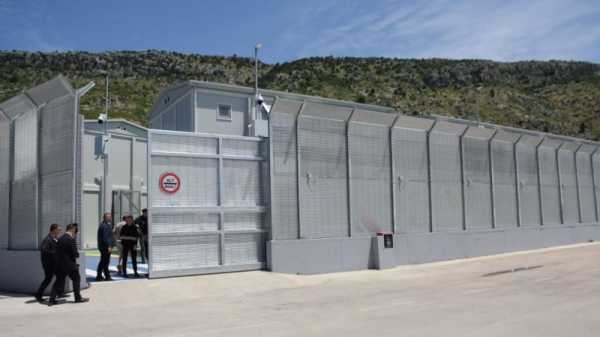
A migrant processing centre set up in Albania as part of an agreement between Italy and Albania will start operating next week, Italian Interior Minister Matteo Piantedosi announced on Saturday.
The two facilities under the agreement were originally due to open on 20 May, but the date was pushed back multiple times due to delays. Hot weather during the summer months and even several wildfires meant the Gjader site, which has 880 beds, was not made ready until 9 October. The other centre in Shengjin, which can accommodate around 200 people, will carry out identification and registration procedures to relieve the burden on Italian reception centres.
“Waimng to start next week, although we hope it won’t be necessary, meaning we don’t have to transfer people there. Everything depends on what happens in the Mediterranean,” Piantedosi said on Saturday at an event organised by Il Foglio newspaper.
The minister added that, given the continued flow of migrants, it is “quite likely” that the first individuals will be transferred to the Albanian facilities in the coming days.
The minister stressed that the Albanian facilities are comparable to those in Italy, clarifying that they are “light containment centres, not detention facilities (CPR).”
“There is no barbed wire; assistance is provided, and all can apply for international protection,” Piantedosi added.
In November, Italian Prime Minister Giorgia Meloni and Albanian Prime Minister Edi Rama agreed to set up Italian-run migrant processing centres in Albania. The agreement, initially for five years with a possible five-year extension, allows Italy to transfer migrants rescued by Italian ships, but not by international NGOs, directly to the two newly built centres in Albania.
They will remain in closed centres while their applications are processed, and when a decision is made, they will be transferred either to Italy, home, or a third country. The site remains under Italian jurisdiction and will be guarded internally by Italian authorities.
This externalisation of border control has been well received by the European Union and several of its leaders, who see it as a model for managing increasing migration flows.
UNHCR staff will monitor the centres to ensure that migrants’ rights are respected and migrants will have access to healthcare and legal assistance.
Meanwhile, the EU’s Court of Justice could review the deal after a recent but non-binding ruling on 4 October that struck down Italy’s designation of “safe countries of origin”, casting doubt on the legal framework underpinning the Italy-Albania agreement.
The media and the opposition have also criticised the deal for a lack of transparency in contract management. An investigation by the Domani newspaper revealed that over €60 million was awarded without a tender.
The investigation has sparked a reaction from opposition parties, who are now demanding clarity on how public funds were used to build two migrant detention centres in Albania.
Both the Green and Left Alliance and the Democratic Party have announced plans for a parliamentary inquiry.
“What has been the total amount spent so far constructing the centres in Gjader and Shengjin in Albania? And who has been involved?” Democratic groups in parliament and the senate asked the government.
“The government must make public the list of companies, including subcontractors, involved in the construction and subsequent management of the two centres in Gjader and Shengjin, and clarify the criteria used to select them to ensure full transparency given the sensitivity of the issue,” they added.
(Alessia Peretti | Euractiv.it)
Source: euractiv.com



